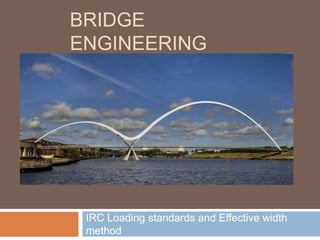This document discusses load standards and the effective width method for bridge engineering according to the Indian Roads Congress (IRC). It outlines various loads that must be considered in bridge design like dead load, live load, impact load, and wind load. It also describes the IRC's standard load classifications for bridges and provides equations for calculating impact percentage and effective slab width. The effective width method per the IRC is described for slabs spanning in one or two directions and cantilever slabs.
















































